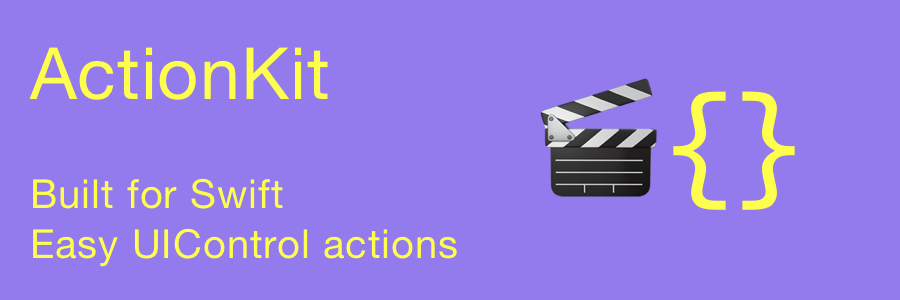ActionKit is a light-weight, easy to use framework that wraps the target-action design paradigm into a less verbose, cleaner format. It shortens target-action method calls by removing the target and replacing the selector with a closure.
button.addTarget(self, action: #selector(MyViewController.buttonWasTapped(_:)), forControlEvents: .TouchUpInside)func buttonWasTapped(sender: Any) {
if let button = sender as? UIButton {
button.setTitle("Button was tapped!", forState: .Normal)
}
}
button.addControlEvent(.touchUpInside) { (control: UIControl) in
guard let button = control as? UIButton else {
return
}
button.setTitle("Button was tapped!", forState: .Normal)
}ActionKit is available through CocoaPods. To install it, simply add the following line to your Podfile:
pod 'ActionKit', '~> 2.3.0'
-
- Add the following to your Cartfile:
github "ActionKit/ActionKit" == 2.3.0
-
- Run
carthage update
- Run
-
- Add the framework as described in Carthage Readme
ActionKit extends target-action functionality by providing easy to use methods that take closures instead of a selector. ActionKit uses a singleton which stores the closures and acts as the target. Closures capture and store references to any constants and variables from their context, so the user is free to use variables from the context in which the closure was defined in.
- Add an action based closure to any
UIGestureRecognizersubclass (eg.UITapGestureRecognizer,UIPanGestureRecognizer...) instead of needing to use the target-action mechanism - Remove actions added to
UIGestureRecognizersubclasses - Add an action based closure to any
UIControlsubclass (eg:UIButton,UIView,UISwitch...) instead of needing to use the target-action mechanism - Remove actions added to
UIControlsubclasses - Add an action based closure to any
UIBarButtonItem, instead of needing target-action - Remove actions added to
UIBarButtonItems
- addControlEvent(_ controlEvents: UIControlEvents, _ closure: @escaping () -> ())
- addControlEvent(_ controlEvents: UIControlEvents, _ controlClosure: @escaping (UIControl) -> ())- addControlEvent(_ controlEvents: UIControlEvents, _ closure: @escaping () -> ())button.addControlEvent(.touchUpInside) {
self.button.setTitle("Button was tapped!", forState: .Normal)
}switch.addControlEvent(.valueChanged) {
[weak self]
self?.demoLabel.text = "Switch value changed!"
}When no closure parameter is given, be aware that any references to the original control are by default a strong reference to that object. However, as shown in the second example by adding the [weak self] annotation, this is instead a weak reference and will not risk causing a retain cycle.
- addControlEvent(_ controlEvents: UIControlEvents, _ controlClosure: @escaping (UIControl) -> ())button.addControlEvent(.touchUpInside) { (control: UIControl) in
guard let button = control as? UIButton else {
return
}
button.setTitle("Button was tapped!", forState: .Normal)
}switch.addControlEvent(.valueChanged) { (control: UIControl) in
[weak self]
guard let switch = control as? UISwitch,
let strongSelf = self else {
return
}
strongSelf.demoLabel.text = "Switch value changed!"
switch.backgroundColor.toggle()
}With a closure parameter, there can still be strong references to the parent class. This example shows how to use a guard to unwrap the weak self, and otherwise abort the closure. Once unwrapped, further optional chaining is unneeded, a nice syntactic outcome.
- removeControlEvent(controlEvents: UIControlEvents)button.removeControlEvent(.touchUpInside)When a UIControl with associated actions is removed from it's superview, all associated actions are removed. This behavior can be overriden, but should be done at your own risk. This behavior currently ensures references to UIControls aren't kept longer than needed (and therefore causing a memory leak through a reference cycle).
- init(_ name: String, closure: @escaping () -> ())
- init(_ name: String, gestureClosure: @escaping (UIGestureRecognizer) -> ())- init(_ name: String, closure: @escaping () -> ())var singleTapGestureRecognizer = UITapGestureRecognizer() {
self.view.backgroundColor = UIColor.redColor()
}var panGestureRecognizer = UIPanGestureRecognizer() {
[weak self]
self?.view.backgroundColor = UIColor.redColor()
}- init(_ name: String, gestureClosure: @escaping (UIGestureRecognizer) -> ())var singleTapGestureRecognizer = UITapGestureRecognizer() { (gesture: UIGestureRecognizer) in
if gesture.state == .Began {
let locInView = gesture.locationInView(self.view)
...
}
}var panGestureRecognizer = UIPanGestureRecognizer() { (gesture: UIGestureRecognizer) in
if gesture.state == .Cancelled || gesture.state == .Ended {
let locInView = gesture.locationInView(self.view)
...
}
}- addClosure(name: String, closure: () -> ())
- addClosure(name: String, closureWithGesture: (UIGestureRecognizer) -> ())singleTapGestureRecognizer.addClosure("makeBlue") {
self.view.backgroundColor = UIColor.blueColor()
}- removeClosure(_ name: String)singleTapGestureRecognizer.removeClosure("makeBlue")When a UIGestureRecognizer is no longer needed, any references kept in closures added to the gesture need to be removed. Either by calling removeClosure as shown above for each named closure, or by simply calling clearActionKit() on the gestureRecognizer which will remove all associated named closures for the recognizer.
// Init with image
- init(image: UIImage, landscapeImagePhone: UIImage? = nil, style: UIBarButtonItemStyle = .Plain, actionClosure: () -> Void)
// Init with title
- init(title: String, style: UIBarButtonItemStyle = .Plain, actionClosure: () -> Void)
// Init with barButtonSystemInit
- init(barButtonSystemItem systemItem: UIBarButtonSystemItem, actionClosure: () -> Void) // Init with image
- init(image: UIImage, landscapeImagePhone: UIImage? = nil, style: UIBarButtonItemStyle = .Plain, actionWithItem: UIBarButtonItem -> Void)
// Init with title
- init(title: String, style: UIBarButtonItemStyle = .Plain, actionWithItem: UIBarButtonItem -> Void)
// Init with barButtonSystemInit
- init(barButtonSystemItem systemItem: UIBarButtonSystemItem, actionWithItem: UIBarButtonItem -> Void) let titleItem = UIBarButtonItem(title: "Press me") {
print("Title item pressed")
}
let image = UIImage(named: "alert")!
let imageItem = UIBarButtonItem(image: image) { (item: UIBarButtonItem) in
print("Item \(item) pressed")
}
let systemItem = UIBarButtonItem(barButtonSystemItem: .Action) {
print("System item pressed")
}- addActionClosure(actionClosure: () -> ())
titleItem.addActionClosure {
print("new action")
}
- clearActionKit()
titleItem.clearActionKit()
Licensed under the terms of the MIT license. See LICENSE file





